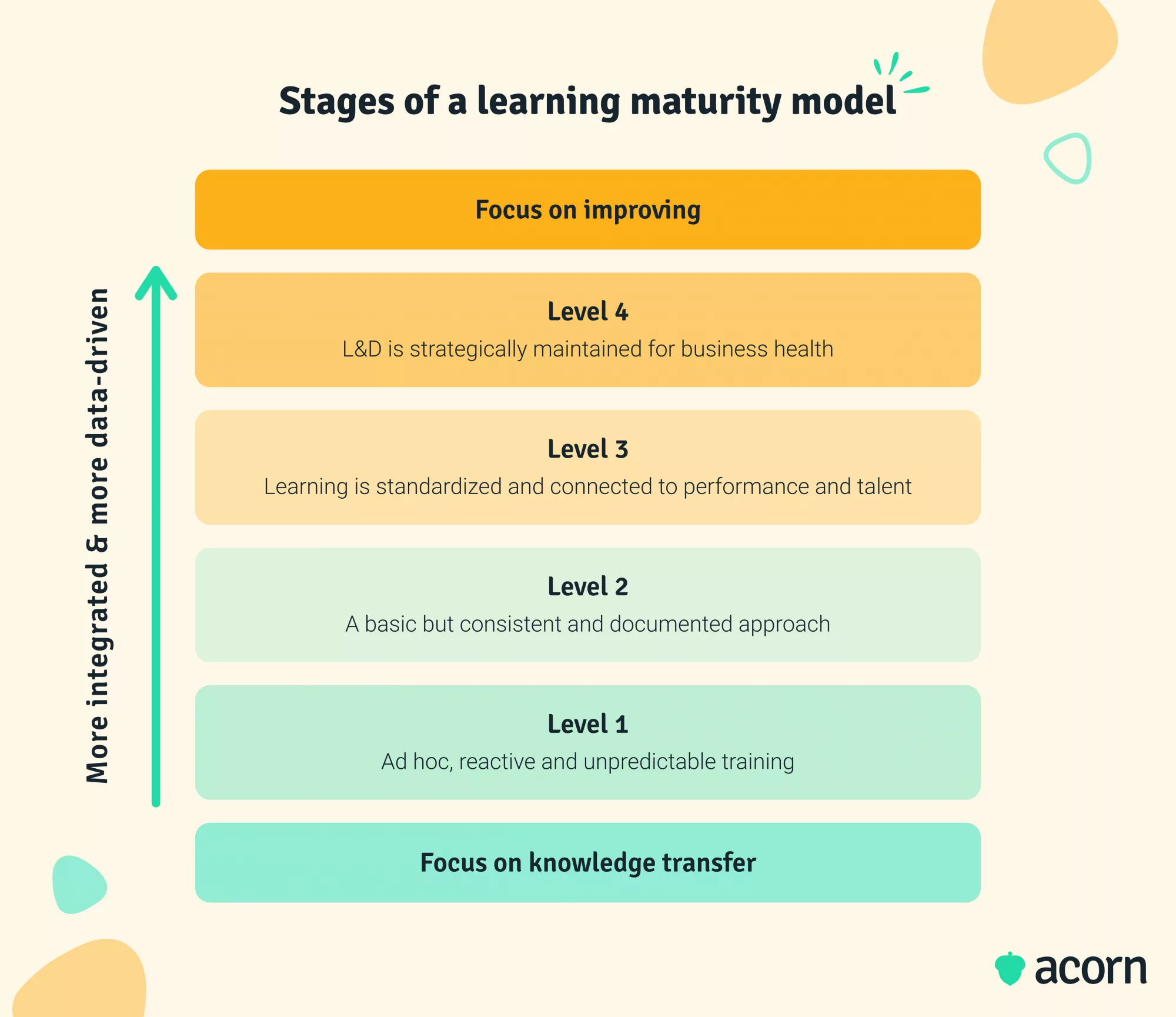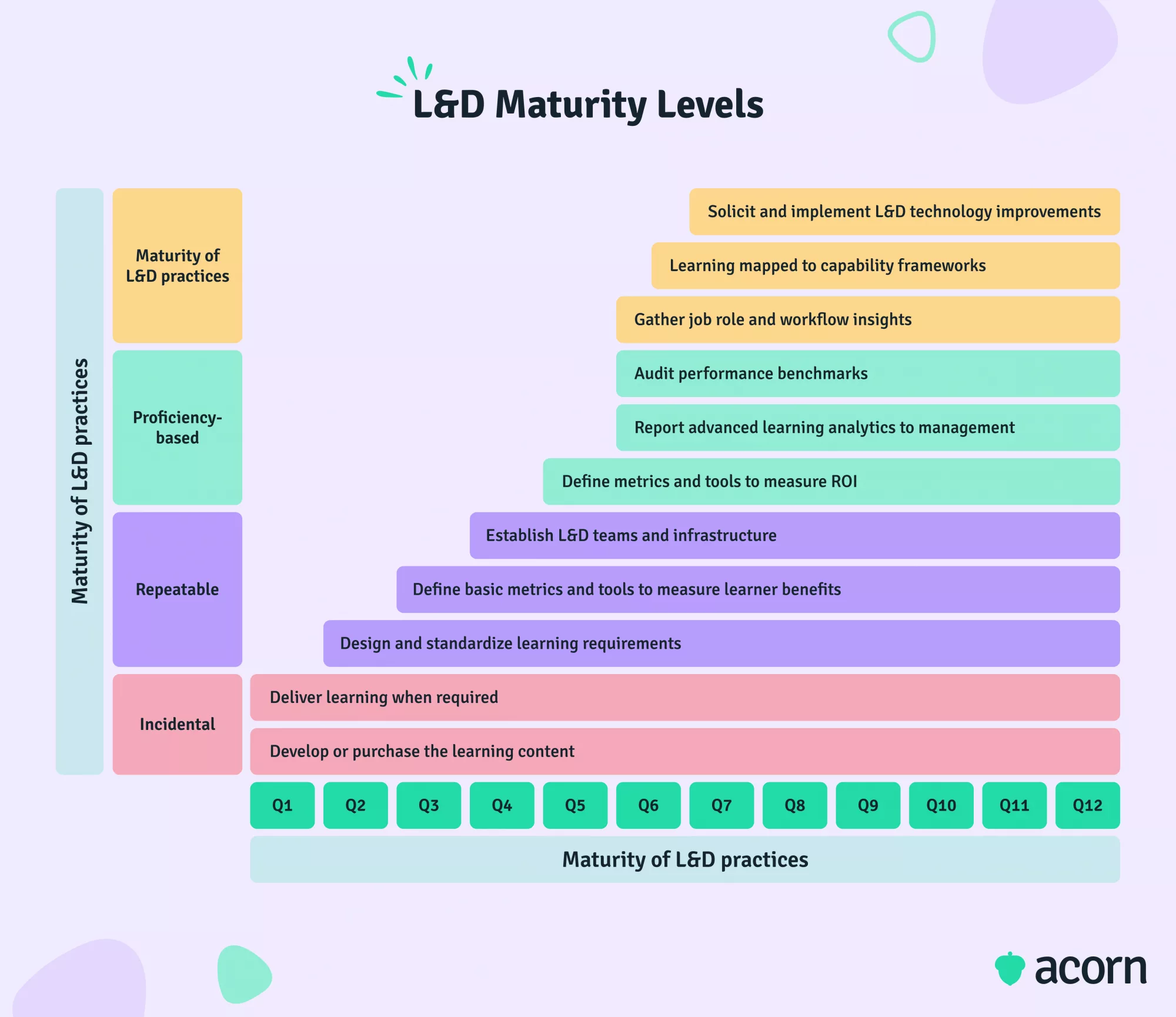How High-Impacts Orgs Use an L&D Maturity Model
Reading Time: 8 minutes

Contents
Lead the pack with the latest in strategic L&D every month— straight to your inbox.
SubscribeDo you know your why, how, what, who, and when for impactful L&D? No? Let us introduce you to the L&D maturity model.
Learning maturity focuses on learning and development (L&D) initiatives, purpose and mindsets in your organisation. Organisations with a mature, optimised or anticipatory learning culture are generally agile market leaders. On the other end of the scale, immature learning cultures are reactive with little long-term benefits. (It’s a harsh reality.)
Here, we’ll talk through learning maturity models, the different levels you can pass through, and just why you should care about creating a mature learning culture.
What is learning maturity?
Learning maturity refers to the culture surrounding an organisation’s learning and development practices and beliefs. It describes a progressive variation in the delivery, resources, objectives and results of employee training within a specific company or team.
What is a learning maturity model?
L&D is a true business driver these days, which is why it can be managed as one would a business. A culture of high performance can and should be developed and nurtured for several reasons.
Maybe L&D is non-existent in a start-up. Perhaps uptake for a popular program has suddenly declined, and the culture around learning that new skill or knowledge diminishes. It could be that talent development is thriving but the link to business strategy isn’t quite there. All of the above are natural occurrences in a learning ecosystem and can be mitigated and improved upon with a learning maturity model.
Using a learning maturity model gives your organisation:
- Repeatable actions for company-wide improvement
- A basis for industry benchmarking
- A tool for comparison between teams internally.
Most learning management maturity models sit at four or five levels. This lifecycle starts at informal and inconsistent practices and peaks at a strategic, company-wide tool that supports the wellbeing of the organisation.

Think of it like belts in martial arts. Different levels of the learning maturity model equate to a new degree of L&D execution and quality. Every current stage takes knowledge and practices from the previous one.
Understanding your organisation’s learning culture
You’re familiar with your workplace culture. You may be less likely to label your learning culture, but it does exist. Knowing where you’re at is important for effectively utilising resources, talent and skills now and in the future.
Then there’s the fact that learning maturity can differ between teams within your organisation. Plus, learning culture filters down; it’s not just the formal training opportunities but the off-the-cuff moments that empower learning in the flow of work.
There are a few factors you can test your current learning maturity on:
- Types of training
- Objectives
- Resourcing
- Modes of delivery.
Type
We’re talking onboarding, compliance, product, upskilling, leadership… there are a multitude of training modes you could offer.
Purpose
What are the objectives of your current methods of training? Personal or professional development? Skills gaps? Prepare them for leadership?
Investments
This doesn’t just mean how you’re spending (though it matters). Consider if you have an L&D team in place, any technology that supports L&D, and how you measure the effects of training.
Delivery
Think eLearning, like learning management systems (LMSs) or learning experience platforms (LXPs), social or collaborative platforms like Microsoft Teams or Slack, and even day-to-day interactions.
L&D maturity levels
Many models talk in levels, but we prefer to discuss phases. The reason being that if learning maturity is a continuum, then it stands that you’ll likely work within each and every phase at some point. And since every phase is informed by the last, you’re never relegated to one—provided you want to up your game, that is.

Let’s take a look at the four phases of L&D maturity.
Phase 1: React

At this phase, the goal is to ensure your employees know their stuff in order to effectively perform their role as it stands. Institutional knowledge is what is being shared, with learning content often unique to the organisation’s processes or services. Most often, training at this maturity level is reactive e.g., courses provided solely on workplace procedures, new products and/or services.
Note: This is still a valuable type of training, particularly for newbies during onboarding, and can happen all day, every day amongst peers (that’s social learning) even at the highest maturity level. Over time, though, you’ll find routinely short-term training is ultimately inconsistent, not easily replicated and expensive.
Phase 2: Standardise

From react, we move to developing a training function or arm. A learning strategy enters the chat through compliance training and professional development. You start to see design thinking in learning solutions, such as basic learning goals and L&D management, giving organisations some oversight and control of training expenses. Those teams start to flesh out their standardised programs with instructor-led and online training, blended learning, proficiency grading and infrastructure such as an LMS that empowers self-directed learning. Many corporate universities emerge here.
L&D at this maturity level is consistent and repeatable, but still fairly basic and top-down.
Phase 3: Improve

The learning culture here has matured to align L&D with business planning, and we begin to hint at a connection between performance management and business goals, too. L&D team leaders have oversight of learning strategy. Quantifiable objectives are in place for quality control—processes are predictable because L&D teams have a continuous flow of data to inform learning pathways. In other words, training is contextualised for application within the organisation and learning strategies begin to look to continuous improvement.
Learning activities are matched to roles and designs are made for return on investment (ROI), including revenue gains, leadership training, talent management and performance management, and succession planning. L&D teams don’t just exploit the full capabilities of an LMS, they overlay it with other emerging ed tech like LXPs. Hands-off, self-directed learning with the aim of career progression is in place, making learning deeply embedded in the company culture.
Phase 4: Anticipate

The learning process here is refined but iterative, based on technology and multiple streams of data. Stakeholders are engaged, learning is constant and mapping learning content to capabilities is the big game in the name of long-term success. In this last phase, the focus is different. While organisations at this stage incorporate the practices of the preceding stages, weight is given to understanding the daily life of employees and their job-related needs. Capabilities are being analysed and mapped to learning content, often using AI-enabled learning and HR software.
5 ways a mature learning culture powers your business success
As analyst Josh Bersin says, architecting your business for change is critical. Technological, economic, competitive and customer shifts can and will interrupt your plans at any given time. You can plan for that, of course, but it’ll bolster any of your efforts to have agility woven into the fabric of your organisation.
Leveraging learning isn’t all that high-impact organisations do, but it is a crucial part of how they align the employee lifecycle with business objectives and strategy. Optimised learning helps:
- Attract & hire cream of the crop
- Develop skills fit for purpose
- Outperform competition
- Match pace of change
- Boost return on investment.
Attract & hire top talent
This point has a few points of its own to note:
- Knowing your skills gaps allows you to hire for those skills when it’s more efficient and effective to recruit rather than train (and good practice is knowing what you can and can’t train for, given workforce trends).
- Mature learning cultures are highly desirable to lifelong learners—aka the type of employee you want to help prop up a mature learning model.
- Top talent are likely those who can keep up with the pace of change, thanks to mission-critical capabilities like adaptability, digital literacy and people management.
Train for a purpose
Training for compliance, industry and institutional knowledge will always have its place. But the larger shift in L&D is towards developing organisational capabilities. (We note here that the learning maturity model actually evolved from the Capability Maturity Model. Coincidence?)
Content that targets gaps, opportunities or risks—i.e., carefully curated content—solves the (non) issue of having millions and millions of quality pieces of eLearning content available to learners. But it also means you can develop the technical skills that may take your business (and business goals) to the next level by evolving, reinventing or expanding your wheelhouse.
Outperform competition
If L&D can be continuously measured and improved, and it’s used as a tenet of good business practice, then it stands that your organisation can consistently evolve in an upwards trend. The Bersin Academy found that high-impact learning organisations experience three times greater profit growth than their competitors. It’s as simple as constantly keeping skills current (how’s that for alliteration), so your organisation can match change and continue to achieve business objectives.
Keep pace with technology
Consider that a little over 10 years ago, Instagram, Slack and Netflix as we know them didn’t exist—but we’d hedge a bet you can masterfully use at least one. Even 4G networks didn’t arrive until early 2010. The point is technology changes fast, yet society and work are so intertwined with it. If you’re built to learn as you go (and as technology, for a lack of better word, goes too), adapting and evolving roles even at an individual contributor level will be much easier.
Increase revenue gain
It’s proven that business performance directly correlates to the maturity of an organisation’s learning culture. Not only do results compound at an organisational level, but research shows that the individual experiences of employee development impact ROI. At an anticipatory maturity level, training for capabilities means you can also forecast potential gains and plan for worst case scenarios, too.

In conclusion
In the realm of business planning, there are many tools that can drive business success: Workforce planning, capability mapping, learning and development. Industry-leading companies know that what underpins all of these practices is learning maturity.
Planning for learning maturity helps organisations understand the distance between their current state and desired future. It also gives weight to the delivery, purpose and impact of learning—or weight to the argument for change. Optimising and managing learning culture means technology, people and processes are perfectly aligned and provides employees and companies a shared purpose for professional development.